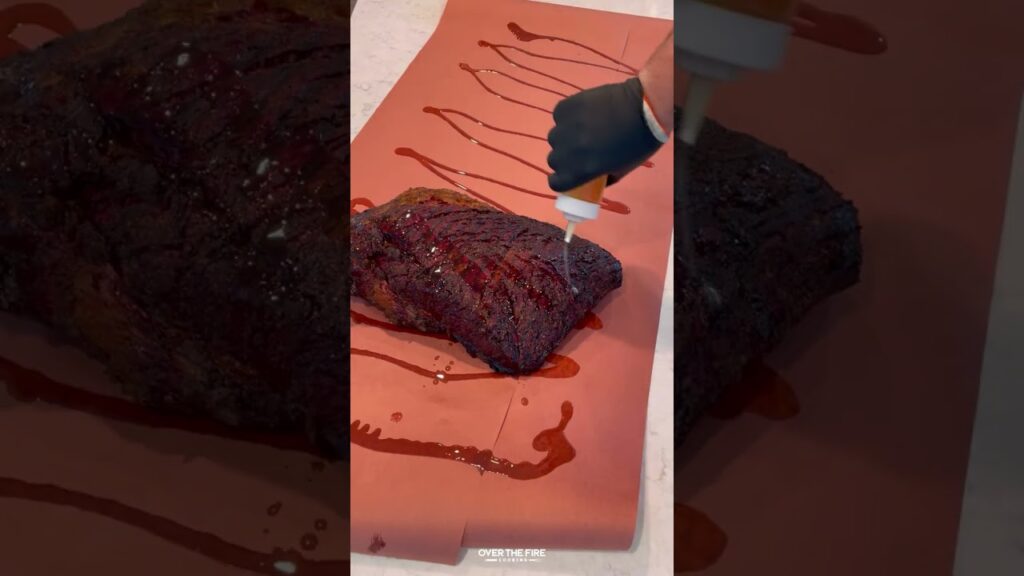Texas Smoked Brisket Recipe Over The Fire Cooking by Derek Wolf showcases a simple, bold Texas approach: a salt-and-pepper-forward rub (with optional garlic powder), long low-and-slow smoking, a butcher paper finish, and a final touch of beef tallow for extra juiciness. You’ll get a sense of the deep smoke flavor and tender texture that make this a barbecue favorite.
This article will give you precise ingredient amounts, step-by-step smoking times and target internal temperatures, practical tips on wood choices and seasoning tweaks, plus serving suggestions and doneness cues. Follow the video’s details exactly to reproduce Derek Wolf’s method and end up with reliably tender, flavorful brisket.

This image is property of i.ytimg.com.
Article metadata and source
Title: Texas Smoked Brisket Recipe Over The Fire Cooking by Derek Wolf
This article covers “Texas Smoked Brisket Recipe Over The Fire Cooking by Derek Wolf” and lays out Derek’s method for a classic Texas-style brisket cooked low and slow, wrapped in butcher paper, and finished with beef tallow for extra juiciness.
Source: Over The Fire Cooking video and blog by Derek Wolf
The instructions here are based on Derek Wolf’s Over The Fire Cooking video and blog post demonstrating his Texas smoked brisket technique: simple seasoning, steady low heat, unwrapped smoke to develop bark, a butcher-paper wrap, and finishing to probe-tender doneness.
Purpose of article: detailed, step-by-step recipe and guidance based on Derek Wolf’s Texas smoked brisket method
This article gives you a detailed, step-by-step recipe and practical guidance so you can replicate Derek Wolf’s Texas-style smoked brisket at home, with exact measurements, target temperatures, timing guidance, and cooking cues to help you succeed.
Introduction
Texas smoked brisket is celebrated for its deep smoky bark, simple salt-and-pepper seasoning, and luscious, tender interior. You’ll be working with a whole packer brisket, focusing on technique more than complicated flavors: coarse salt, coarse black pepper, optional garlic powder, a bit of beef tallow, and patient low-and-slow smoking. The result is classic Texas barbecue — bold, beef-forward, and richly textured — and this recipe walks you through each step so you can get reliable results on your smoker or offset pit.
Equipment and tools needed
Smoker or offset pit capable of holding a steady 225°F
You need a smoker or offset pit that can maintain a steady 225°F (107°C) for the long duration of the cook; temperature stability is one of the most important factors for consistent brisket results.
Instant-read thermometer and at least one leave-in probe thermometer
Use an instant-read thermometer for quick spot checks and a leave-in probe thermometer placed in the thickest part of the flat so you can monitor internal temperature continuously during the cook.
Butcher paper (peach/pink) for Texas-style wrap
Peach (pink) butcher paper is the preferred wrap here because it breathes more than foil, preserves bark texture, and finishes the cook while holding juices — have enough to wrap your full packer brisket tightly.
Sharp boning or trimming knife and cutting board
A sharp boning or trimming knife and a sturdy cutting board are essential for trimming the brisket properly and for slicing after the rest; clean, confident cuts make a big difference in presentation and texture.
Aluminum foil and towels for a cooler rest
Use aluminum foil for any temporary cover and have towels and a cooler ready to cradle the brisket during a post-cook rest so it stays warm and finishes settling its juices without overcooking.
Heatproof gloves, tongs, and drip pan
Wear heatproof gloves for safety when handling hot meat and paper, use long tongs to move things around safely, and place a drip pan beneath the cooking grate to catch drippings and keep your smoker cleaner.
Ingredients list (exact measurements)
Below is the complete ingredient list with precise measurements required by Derek Wolf’s method. Do not substitute amounts if you want the same seasoning balance.
Packer brisket (flat + point), 12 pounds recommended (10–14 lb range acceptable)
Choose a whole packer brisket weighing about 12 pounds for this recipe; briskets in the 10–14 pound range will work with the same method and timing guidelines.
Kosher salt (or coarse sea salt), 1/4 cup
Use 1/4 cup of kosher salt or coarse sea salt as the salt component of the rub; the coarse crystals are key to classic Texas bark and seasoning.
Coarse black pepper (freshly cracked coarse grind), 1/4 cup
Use 1/4 cup of coarse black pepper, freshly cracked if possible; coarse pepper is central to the traditional Texas pepper-forward bark.
Garlic powder (optional), 1 tablespoon
Add 1 tablespoon of garlic powder only if you want that extra savory note — it’s optional and consistent with Derek’s suggested variant.
Beef tallow, melted, 2 tablespoons (for added juiciness)
Melt 2 tablespoons of beef tallow to brush over the brisket before applying rub and optionally a small drizzle before wrapping; it helps rub adhesion and adds juiciness.
Wood for smoking: post oak, oak, or a blend of oak and pecan (see Tips for alternatives)
Use post oak, oak, or a blend of oak and pecan for a classic Texas smoke flavor; you’ll manage wood choice and amounts to maintain a clean, thin blue smoke throughout the cook.

This image is property of images.pexels.com.
Brisket selection and trimming
Choose a whole packer brisket with good marbling, 10–14 lb ideal
Select a whole packer brisket that includes both the flat and point and has visible marbling; a 10–14 pound size is ideal because it balances manageable cooking time with enough mass to develop good bark and moist interior.
Trim fat cap to approximately 1/4 inch thickness; remove silver skin and hard pockets of fat
Trim the fat cap down to about 1/4 inch so it protects and bastes the meat but doesn’t prevent rub penetration or proper rendering; remove any silver skin and dense, hard pockets of fat that won’t render during the cook.
Square the brisket edges so it lays flat and cooks evenly
Square off any irregular edges so the brisket lays flat on the smoker grate; even contact and a uniform surface help the meat cook more consistently and reduce the chance of thin edges overcooking.
Note which direction the grain runs on both flat and point to plan slicing later
Identify the grain direction on both the flat and point before cooking so you can slice against it later for maximum tenderness — the flat and point often have different grain orientations.
Seasoning and rub application
Prepare simple Texas rub: combine 1/4 cup kosher salt, 1/4 cup coarse black pepper; add 1 tablespoon garlic powder if desired
Mix the rub by combining 1/4 cup kosher salt and 1/4 cup coarse black pepper; if you want the optional garlic note, add 1 tablespoon garlic powder and stir until even.
Melt 2 tablespoons beef tallow and lightly brush over the brisket to help the rub adhere and promote moisture
Melt 2 tablespoons of beef tallow and lightly brush it over the exterior of the trimmed brisket; the tallow helps the rub adhere, adds a surface fat layer to start rendering, and contributes to juiciness.
Evenly coat the entire brisket with the salt/pepper/(garlic) mixture, pressing the rub into the meat for full coverage
Apply the rub evenly over the entire brisket, pressing it gently into the surface so it adheres and forms an even seasoning layer; don’t over-handle the meat — you want full coverage but a light press.
Let seasoned brisket rest at room temperature 30–45 minutes while smoker stabilizes, or refrigerate overnight uncovered for deeper bark (optional)
After seasoning, let the brisket sit at room temperature for 30–45 minutes while you bring the smoker to temp, or optionally refrigerate it uncovered overnight to dry the surface for an even darker, firmer bark; if refrigerating, bring back to room temp before smoking.

This image is property of images.pexels.com.
Pre-smoke setup and fire management
Stabilize smoker temperature at 225°F (107°C) for low & slow smoking
Set up your smoker and stabilize it at 225°F (107°C) — this steady low temperature is the foundation of long, even cooking and controlled fat rendering for a tender result.
Use hardwood lump charcoal as base fuel and add chunks of post oak or oak for smoke flavor; maintain clean, thin blue smoke
Use hardwood lump charcoal for consistent heat and add chunks of post oak, oak, or a blend (or oak/pecan) for smoke flavor. Aim for clean, thin blue smoke rather than heavy white smoke; heavy, acrid smoke can impart bitter flavors.
Set up for indirect heat and place a drip pan under the cooking grate to catch drippings
Arrange for indirect heat so the brisket is not directly over open flame, and place a drip pan beneath the grate to catch drippings, reduce flare-ups, and help keep your smoker cleaner during the long cook.
Place probe thermometer in the thickest part of the flat and monitor throughout cook
Insert your leave-in probe into the thickest part of the flat before you begin smoking so you can monitor internal temperature continuously and rely more on temps and probe feel than on time alone.
Smoking — unwrapped low & slow stage
Place the brisket on the smoker with fat cap up to protect the meat and let rendered fat baste the brisket
Put the brisket on the smoker with the fat cap facing up; this position allows rendered fat to baste the meat surface and helps protect the leaner flat during the initial smoke phase.
Smoke at a steady 225°F until the brisket reaches an internal temperature of 160–165°F or until a desirable dark bark forms
Smoke the brisket at 225°F until it reaches about 160–165°F in the thickest part of the flat or until you have a dark, set bark — these are the cues Derek uses to decide when to wrap.
Estimate time for this stage as part of ~1 to 1.25 hours per pound total cook time; for a 12 lb brisket expect roughly 6–9 hours unwrapped before wrapping depending on conditions
Use the estimate of roughly 1 to 1.25 hours per pound for total cook time as a guideline; for a 12 lb brisket, expect approximately 6–9 hours in the unwrapped stage before wrapping, but let temperature and bark development guide you more than the clock.
Check smoke color regularly and add wood as needed to maintain thin blue smoke; avoid heavy acrid smoke
Monitor the smoke frequently and add wood chunks as needed to sustain a thin, blue smoke; avoid producing heavy, white or acrid smoke — it will impart unpleasant flavors and can stall bark development.

This image is property of images.pexels.com.
Wrapping in butcher paper and adding beef tallow
When internal temp reaches ~160–165°F and the bark is set, remove brisket and wrap tightly in butcher (peach) paper
Once the brisket hits roughly 160–165°F and you have a firm, dark bark, remove it from the smoker and wrap it tightly in peach butcher paper; wrapping helps push the brisket through the stall while preserving bark texture better than foil.
Before sealing, optionally brush or drizzle the brisket with remaining melted beef tallow (approximately 1–2 tablespoons) to add moisture and help finish rendering
Before sealing the butcher paper, you can optionally add about 1–2 tablespoons of the remaining melted beef tallow over the brisket; this adds a little extra moisture and helps the fat continue to render during the finish stage.
Wrap seams tight but allow a little room for juices; return wrapped brisket to smoker, seam-side down if possible
Seal the butcher paper with the seam tight but not crushed shut — let a small amount of room remain for juices to pool slightly — and return the wrapped brisket to the smoker, preferably seam-side down to reduce seam opening.
Smoking — finish stage to target doneness
Continue smoking wrapped brisket at 225°F until internal temperature reaches 203°F and the meat is probe-tender (probe slides in with little resistance)
Keep smoking the wrapped brisket at the same 225°F until the internal temperature reaches about 203°F and the meat becomes probe-tender — that is, a probe or skewer slides into the meat with little resistance. Use both temperature and probe feel to determine doneness.
Expect total cook time approximately 1 to 1.25 hours per pound; for a 12 lb brisket total time typically 12–15 hours but monitor by temperature and probe feel rather than clock alone
Total cook time usually falls in the 1 to 1.25 hour per pound range; for a 12 lb packer brisket you should generally expect 12–15 hours total. Always prioritize internal temperature and probe tenderness over strict timing since brisket and smokers vary.
If brisket seems stalled for many hours, maintain low heat; finishing to a probe-tender state (not only temperature) is the priority
If the brisket experiences a stall (several hours with little temp rise), don’t panic — maintain low, steady heat and judge progress by probe tenderness. Finishing to a probe-tender state is more important than reaching a specific temperature quickly.
Tips
- Wood choices: Post oak is classic Texas wood. If you don’t have post oak, use plain oak or a blend of oak and pecan for a balanced smoke profile. Mix sparingly with fruit woods only if you want a milder sweet note; avoid heavy fruit wood that can overpower the beef.
- Smoke management: Aim for thin blue smoke — if you see thick white smoke, add more airflow or burn off excess smoke before the brisket goes on. Clean smoke prevents bitter flavors.
- Bark and rub: Don’t overwork the rub; press it gently. If you like a darker bark, chilling the brisket uncovered overnight after seasoning helps dry the surface and develop a firmer bark.
- Wrapping choice: Butcher paper breathes and preserves bark texture better than foil. Foil will speed the finish and make bark softer; use foil only if you need to speed the cook or retain more juices in a very lean brisket.
- Probe feel: Learn the probe method — when the probe meets little resistance and slides like softened butter through the meat, it’s done. Temperature is a guideline; tenderness is the definitive cue.
- Resting: Rest wrapped brisket in a towel-lined cooler (no ice) for 1–2 hours to let juices redistribute. You can hold it longer at serving temperatures if needed, but most of the benefit happens in that first couple of hours.
- Food safety: Keep the brisket above safe temperatures during holding and avoid leaving it at room temperature for extended periods after the initial resting period.
Serving Suggestions
You can serve this Texas smoked brisket simply and traditionally: slice the flat against the grain into 1/4-inch to 1/2-inch slices, pull or chop portions of the point for moist servings, and present with classic Texas sides. Good pairings include pickles and sliced white bread, potato salad or coleslaw, baked beans, and minimal sauce so the beef flavor shines. If you prefer sauce, offer a tangy or slightly sweet BBQ sauce on the side so guests can add as they like.
Instructions
Follow these sequential steps to execute Derek Wolf’s Texas smoked brisket method successfully. Rely on temperatures and probe feel rather than just time.
Preparation and trimming:
- Choose a whole packer brisket (10–14 lb, 12 lb recommended). Trim the fat cap to about 1/4 inch, remove silver skin and hard fat pockets, and square the edges so it lays flat. Note the grain direction on both flat and point for slicing later.
Seasoning:
- Melt 2 tablespoons beef tallow. Lightly brush the brisket with the melted tallow. Mix 1/4 cup kosher salt and 1/4 cup coarse black pepper; add 1 tablespoon garlic powder if desired. Evenly apply the rub over the entire brisket and press gently. Let sit at room temperature 30–45 minutes while smoker stabilizes, or refrigerate uncovered overnight for a firmer bark (bring back to room temp before smoking).
Pre-smoke setup:
- Stabilize your smoker or offset pit at 225°F (107°C). Use hardwood lump charcoal as base fuel and add chunks of post oak, oak, or oak/pecan for smoke. Set up for indirect heat and place a drip pan under the grate. Insert a leave-in probe into the thickest part of the flat.
Smoking — unwrapped stage:
- Place the brisket on the smoker with the fat cap up. Maintain a steady 225°F and thin blue smoke. Smoke until the internal temperature reaches about 160–165°F or until you have a desirable dark, set bark. For a 12 lb brisket, this unwrapped phase might take roughly 6–9 hours depending on conditions.
Wrapping:
- Remove the brisket when it reaches ~160–165°F and the bark is set. Brush with an additional 1–2 tablespoons of melted beef tallow if desired, then wrap tightly in peach butcher paper. Seal seams snugly but allow a little room for juices. Return the brisket to the smoker seam-side down if possible.
Smoking — finish stage:
- Continue smoking the wrapped brisket at 225°F until internal temperature is around 203°F and the meat is probe-tender — a probe should slide in with little resistance. Expect total cook time of approximately 1–1.25 hours per pound (about 12–15 hours for 12 lb), but prioritize tenderness over clock time.
Resting:
- When probe-tender, remove the brisket and keep it wrapped. Place it in a towel-lined cooler (no ice) and rest for 1–2 hours to allow juices to redistribute and the temperature to settle.
Slicing and serving:
- Unwrap, note grain direction again, slice the flat against the grain into even slices, and separate/pull the point as desired. Serve with your preferred sides and sauce options on the side.
Conclusion
Key takeaways: select a well-marbled packer brisket, use a simple salt-and-pepper-forward rub, smoke low & slow at 225°F, wrap in butcher paper at the stall, finish to probe-tender ~203°F, rest before slicing
Your main takeaways are straightforward: pick a well-marbled whole packer brisket, keep the rub simple and bold with coarse salt and pepper, smoke low and slow at 225°F, wrap in peach butcher paper when the bark sets around 160–165°F, finish until probe-tender at about 203°F, and rest before slicing for the best texture and juiciness.
Practice and patience are essential — every brisket and smoker behaves differently, so monitor by temperature and probe feel
Practice and patience are your allies: every brisket and every smoker behaves a little differently, so rely on internal temperature and probe tenderness rather than just the clock. Over time you’ll learn how your equipment and local conditions influence the cook.
Encouragement to try Derek Wolf’s method and adapt small details to personal taste while keeping core technique consistent for reliably excellent Texas smoked brisket
Try Derek Wolf’s method as written, then make small, thoughtful adjustments — a slight rub tweak, different wood blend, or wrap timing — to match your taste and setup. Keep the core technique consistent (low & slow, simple rub, butcher paper wrap, finish to probe-tender) and you’ll get reliably excellent Texas smoked brisket. Enjoy the process, and savor the results.
